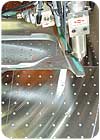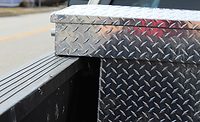
Whether you need to add stability to a final component or optimize a manufacturing process, structural adhesives offer an increasingly broad range of customizable benefits.
Used in conjunction with mechanical fasteners or welds, or as a stand-alone bonding solution, structural adhesives are steadily gaining acceptance with designers and engineers in many industries, partly because they can be formulated to work with various substrates and achieve very specific results.
Traditionally, structural adhesives have been specified to address durability requirements and overcome traditional joining limitations. More recently, they are being considered for crash durability, part stiffness, safety requirements and as a means to address mass reduction. They are also being evaluated for applications where high temperature tolerance, recycling and improved time-to-market are important considerations.
As the acceptance of structural-adhesive technology becomes more widespread, manufacturers are including structural-adhesive application and dispensing infrastructure when updating facilities or building new plants. For instance, since the late 1990s, structural adhesives have become integral to many assembly processes in the automotive industry. New grades of structural adhesives provide high strength and high rigidity while retaining sufficient flexibility under impact at all relevant temperatures, including very low ones.
Applied to structural and non-load-bearing areas, structural adhesives can replace welds and mechanical fasteners, or combine with welds to join similar and dissimilar substrates. Durability is improved by reducing fatigue and failure commonly found around spot welds and fasteners. There is also the potential to lower costs and save manufacturing time by reducing expensive welds without losing mechanical properties.
Dow Automotive uses its material-science capabilities to develop adhesive grades to meet OEM material specifications, processing and cost requirements. Formulas are optimized for unique substrates while providing tailored properties. Some formulas expand to minimize the use of sealers; others contain patented toughening systems to provide fracture resistance over a broad temperature range. Others still bond dissimilar substrates, like steel, aluminum, magnesium and plastic. In some cases, computer-aided engineering is used to optimize metal components, eliminate reinforcements and/or integrate plastic parts, thus allowing for reduction of part thickness, which results in significant weight savings and improved structural performance.
Important considerations to think about when adding adhesives to a manufacturing process include machinery, plant layout and handling and application methods. This is especially true for structural adhesives, which involve materials that are pumpable at the time of application and that chemically cure later in the e-coat ovens.
New developments in adhesive formulation and application are now benefiting manufacturing processes as well as final products. Adhesive technologies are accommodating a widening range of material surfaces, manufacturing processes and performance specifications. Effort has also been dedicated to making adhesives compatible with the diverse requirements of automotive manufacturing. For example, viscosity, wash-off resistance, humidity resistance, storage stability, cure profiles and adhesion to oily substrates are some of the typical concerns to consider for robust automotive manufacturing.
The following case study is proof of this assertion; while it is specific to automotive manufacturing, it has wide-ranging possibilities for manufacturers in many industries.

Case Study: The Customization of a Structural Adhesive to Meet Processing and Performance Requirements
A recent project with a major global automotive manufacturer demonstrates the multi-faceted benefits and formulation flexibility of structural adhesives. The customer approached Dow Automotive in hopes of finding a structural adhesive to replace and/or reduce mechanical fasteners, and simultaneously improve overall vehicle stiffness and crash performance. In addition, the customer wanted to streamline its manufacturing process in a new facility that was under development.Structural bonding trials focusing on application equipment, quality control, body shop manufacturing and paint shop processing were conducted in an effort to develop a new adhesive to provide wash-off resistance without the use of an expensive pre-gel oven. (When a car body is passed through the various cleaning stages, phosphating and electrodeposition baths, it can be subjected to turbulent flow and liquid sprays. As a result, exposed and/or incurred structural adhesives need to stay on the body structure or expensive measures are required to clean the body of residual depositions.)
During the development process for the new structural adhesive, the focus was on achieving simultaneous goals: significantly increasing viscosity at low shear rates (but having low viscosities at high shear rates) and allowing a minimum change with increase in temperature.
Wash-Off-Resistant, Crash-Resistant Structural Adhesive Technology
To avoid a capital investment in expensive pre-gel ovens or pre-curing equipment to secure all adhesive applications in the car body against wash-off in the washing, phosphating and e-coat baths, Dow Automotive worked with the OEM to develop an epoxy-based, wash-off resistant, structural adhesive solution with high fracture toughness for improved durability and crash stability.
Testing
At first, tests were carried out with different structural adhesives. All adhesives were tested without a pre-gelling process to get a classification and an understanding of their behavior at different viscosities and thixotropies.Next, the trials were repeated with pre-gelled adhesives in order to define values for technical standards and tolerances for wash-off resistance.
With substituted adhesive systems, the same trials were carried out until the first adhesives reached the target. At this point, it was necessary to change from lab tests to line trials in a paint shop.
During the line trials, different adhesives were tested. In the first step, joint panels with squeezed-out adhesive were mounted at different positions on a car body. On all panels, a bead of a new, non-pre-gelled test adhesive and a pre-gelled serial adhesive were applied. After the pre-treatment process, both systems were compared and documented. The goal was for the degree of deformation after pre-treatment of the new system to equal the performance of the established pre-gelled system.
The next step was to correlate the results from the previous lab test with a real-life line trial in the paint shop. Several areas of concern were identified, and more information about the fluid flow of the wash was necessary. Measurements were taken at different positions on the car body at different points in the process.
A propeller sensor was used to measure flow in the areas of concern in the pre-treatment line. It was then possible to detect maximum flow speeds and parts of the line where the main force was generated. With this information, new lab trials were carried out. Joint panels with squeezed-out adhesive were mounted to an agitator, and the new adhesives were wash-off resistant up to 1.4m/s. The pre-gelled adhesives showed the same result.
Equipment Changes
The new adhesive systems require a change in dispensing equipment. The equipment pressure has to be raised from 180 bar to 250 bar in order to get constant conditions for application. The equipment was tested by pump trials and in serial production with the new adhesives over a period of three months to implement a stable process.Conclusion
With the development of new adhesive systems and the knowledge of body-in-white and paint shop processes, it is possible to eliminate pre-gelling ovens for structural crash-resistant adhesives. Due to the variances between paint-shop facilities, a thorough understanding of the facility, process and adhesive performance requirements is needed. The development of wash-off-resistant structural adhesives is an important step forward for structural bonding technology.Summary
When considering the addition or substitution of adhesives within a manufacturing process, know that chemistries offer increasing flexibility, enabling the development of customized materials. While the evolution of existing formulations does require cooperation from customers and access to process data and procedures, the final product can save significant costs in terms of time, capital expenditures, and other important industry-specific considerations.For more information on structural adhesives, visit Dow Automotive at automotive.dow.com.

